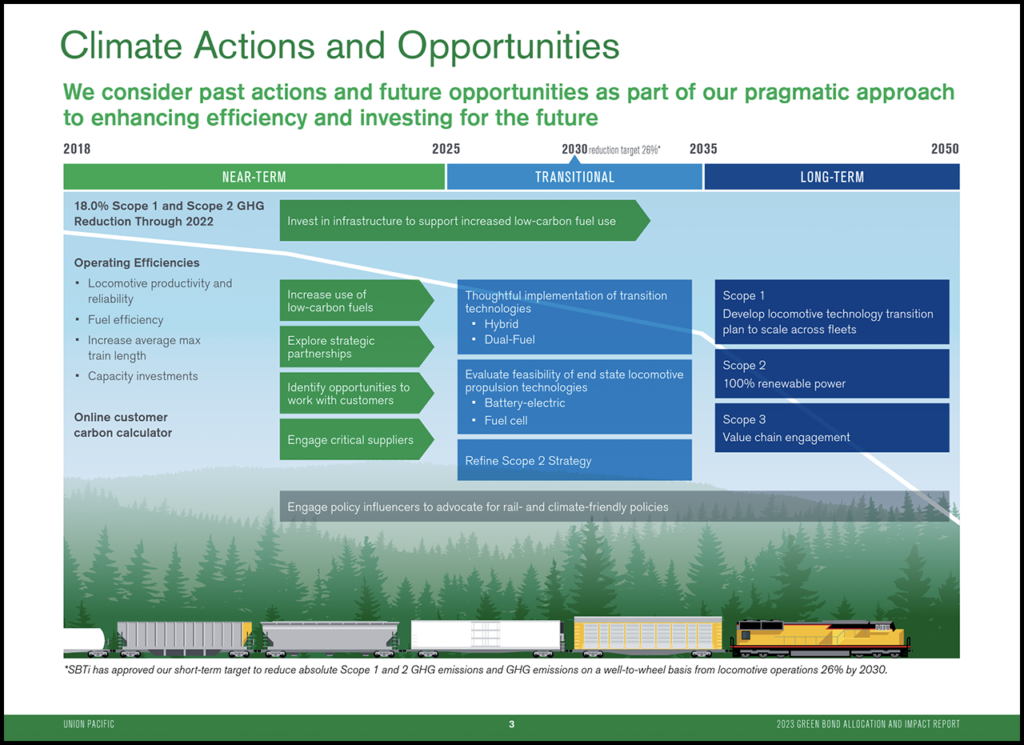
UP: Using Green-Bond Proceeds to Reduce Carbon Footprint
Written by Marybeth Luczak, Executive Editor
Union Pacific (UP) has issued a 2023 Green Bond Allocation and Impact Report, highlighting projects funded by $590.8 million in net proceeds.
UP on Sept. 5 reported that 100% of the green-bond net proceeds were issued in September 2022 and used for projects supporting the railroad’s sustainability initiatives, consistent with its Green Financing Framework.

The allocated projects included:
- $265.5 million for upgrades to existing rolling stock, including locomotive modernizations to reduce greenhouse gas (GHG) emissions and diesel fuel consumption. “Locomotive operations represent our greatest source of GHG emissions,” UP reported. “Emissions from locomotives comprised 94.1% of our 2022 Scope 1 and Scope 2 GHG emissions. Accordingly, most of our focus in reducing our carbon footprint is on our locomotive operations. Our Locomotive Modernization Program completely replaces the electrical control system in our high horsepower fleet, allowing for software updates and functionality required to reduce road failures and variability. In addition, modernizations include a complete rebuild of engines and redesign of the fuel distribution system, resulting in more efficient fuel consumption and reduced emissions. The modernizations also support the circular economy, with components comprising more than half the locomotive’s weight being reused. Additional investments in our low horsepower fleet include our first hybrid diesel-electric locomotives and the installation of emissions upgrade kits that reduce idling fuel consumption. In addition to decreasing fuel consumption and associated GHG emissions, these investments improve locomotive reliability and therefore decrease the size of our active fleet.” UP noted that it expects delivery to begin in late 2024 or early 2025 of the first battery-electric units from Wabtec and Progress Rail that will be tested in yard operations. Despite delays “due to supply chain challenges and the complexity associated with design specifications,” the railroad said, “we’ve begun installing charging systems, electrical distribution infrastructure, yard charging tracks, and shop chargers at rail facilities in West Colton, CA and North Platte, NE, two critical terminals on our rail network. Incorporating battery-electric locomotives into service can help decarbonize our footprint. (Scroll down to read more on UP’s locomotive initiatives.)
- $220.9 million to expand network capacity and promote modal shift of freight to lower-carbon rail. Of this total, $119.8 million has been disbursed on train length initiatives. “Fluid operations reduce train dwell and allow trains to travel at optimal speeds with fewer starts and stops, improving our fuel consumption rate,” UP reported. “In addition, longer train lengths improve locomotive productivity measured in gross ton miles per horsepower day, which typically results in fewer locomotives needed to handle our freight. These reduced locomotive requirements allow us to retire or store our least-efficient units, improving our average fuel efficiency. Better fuel efficiency reduces fuel consumption, which also reduces GHG emissions. This green bond funded a multi-phase strategy to increase train length on our 875-mile Golden State route between El Paso and Kansas City. This corridor is critical in connecting Southern California to the Midwest and is a primary lane for our intermodal service product, further strengthening our business development opportunities to shift freight from trucks to rail.” The remaining $101.1 million has been disbursed to capacity expansion of intermodal facilities. UP has 31 ramps across its 23-state network. “Ramp capacity is critical to meet demand and increase market share in the increasingly competitive trucking market,” the railroad reported. “Intermodal ramp expansion projects funded by this green bond include investments in crucial markets such as Chicago, Southern California and the Twin Cities. Our investments in Chicago included essential capacity improvements in our Global 2 and Global 4 terminals and allowed us to launch the Falcon premium intermodal service, a best-in-class Mexico-U.S.-Canada service with a seamless rail connection in Chicago. At the Inland Empire in California and the Twin Cities, we repurposed existing rail yards to create pop-up intermodal facilities, creating incremental intermodal capacity without requiring new construction. In all, this green bond funding created the capacity for 181,300 annual container lifts, which could remove up to 90,650 long-haul trucks from the highways.”
- $78.1 million for new rolling stock, vehicles and equipment, including electric vehicles and battery-electric locomotives, along with associated charging infrastructure. According to UP, $74.2 million has already been disbursed on refrigerated boxcar acquisitions and upgrades. “The efficiency of the refrigeration unit is impacted by a variety of factors including fuel consumption, insulation, car construction, air flow, and seals,” UP reported. “The new refrigerated boxcars funded in part by this green bond include improved foam insulation of side walls, enhanced interior air flow, a design that minimizes thermal barriers, and a floor with increased life expectancy. During the design phase, a prototype used in perishable service demonstrated a 15%-25% reduction in fuel consumption. Similarly, green bond proceeds funded refrigeration unit replacements on parts of our older fleet, which generate similar fuel consumption savings.”
- $19.9 million in renewable energy investment. This funding has been disbursed on a solar facility. “In 2021, Union Pacific invested in a 124-megawatt solar generation facility covering approximately 700 acres in northeast Texas,” UP reported. “The solar power system harvests thermal energy from the sun and converts it into clean, sustainable electrical energy. During 2022, this facility generated over 246,000 net MWh of solar energy.”
- $6.4 million in energy efficient LED lighting. “As a 24-7-365 operation, lighting is critical to the safety of our operations at yards, terminals, and other facilities across our network,” UP reported. “Proceeds from this green bond funded energy-efficient LED lighting installations at locations in California, Utah and Louisiana.”
“The infrastructure investments funded by the green-bond proceeds underscore Union Pacific’s efforts toward building a more sustainable future and to achieving our climate-change goal of net zero by 2050,” said Beth Whited, who was elevated to UP President on Aug. 14.
Further Reading:
Watch: UP Inks $1B Power-Upgrade Deal with Wabtec
UP Acquiring 20 Battery-Electrics for Yard Service
UP, ZTR Partner on Hybrid-Electric Locomotives



